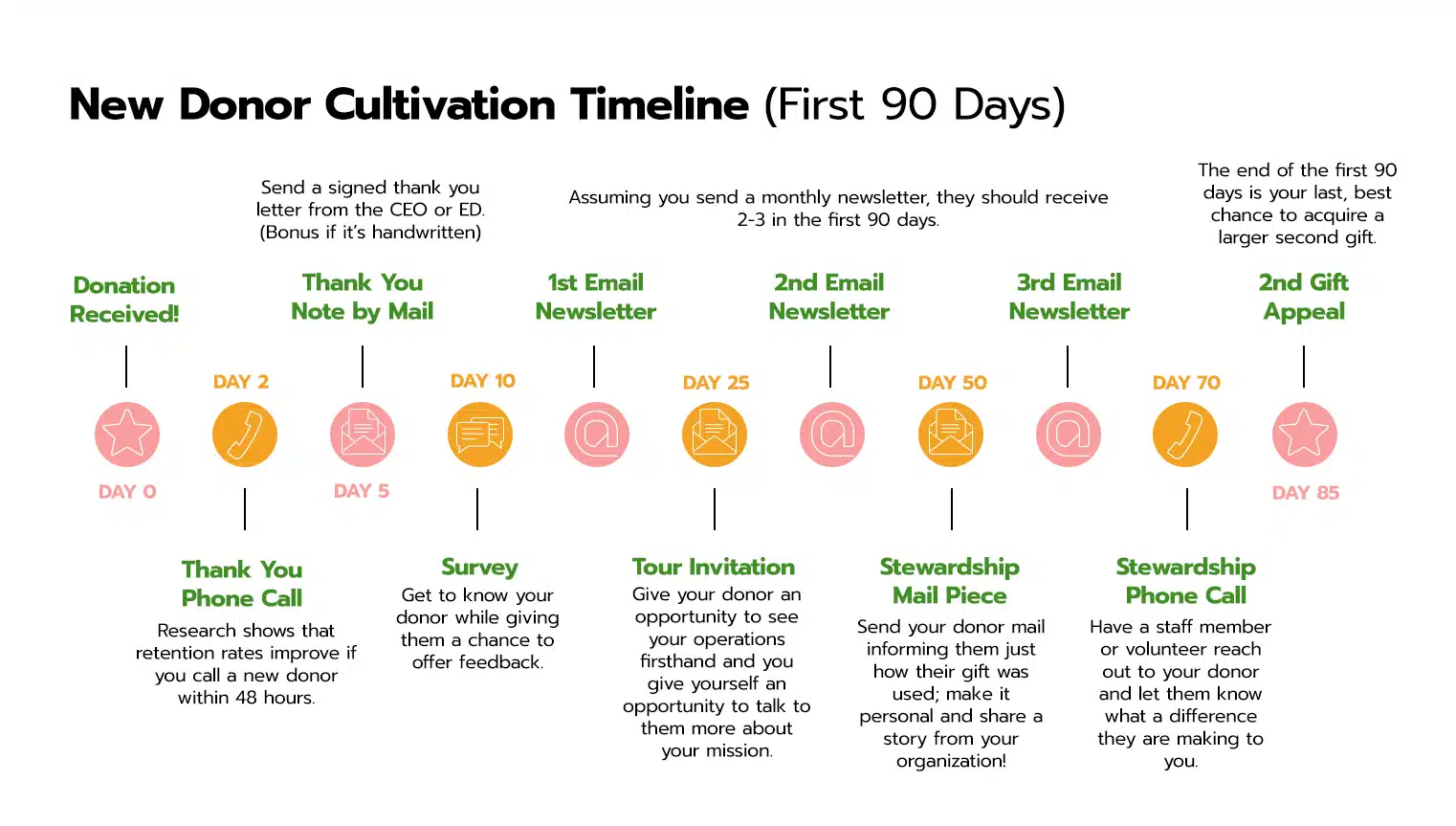From First Gift To Forever: Building Donor Loyalty That Lasts


Full Platform Overview Chat With Us



Full Platform Overview Chat With Us




If you’re like most nonprofits, attracting new donors is a costly endeavor. Yet somehow, it’s the one goal your boss or your board gets the most excited about.
Many nonprofits prioritize donor acquisition over stewardship, treating stewardship strategies as a frivolous or just a ‘nice to have’ endeavor. Cultivation done right isn’t a cost center, however, it’s a revenue center.
If you want to turn one-time donors into lifelong supporters, you need to build out a new, personalized donor cultivation journey.
The image below is a stellar example of how to properly thank, nurture, and then—after 90 days—solicit a new donor.

The sample new donor cultivation timeline above incorporates personalized communication, like phone calls and notes, and regular communication, like email newsletters. It also includes a survey to learn more about the donor and deepen the donor relationship. If you want help putting this into action at your nonprofit, download this free stewardship template.
The greatest gift you can give a donor is the gift of feeling known by you. Stewardship strategies that include personalized donor journeys can help you achieve this. How can you do it? Here’s a checklist to help you create a personalized donor journey that inspires loyalty:
The impact of thanking new donors personally is well documented. In one study, first-time donors who received a personal thank-you call within 48 hours were four times more likely to give again. Would you like to have donors who are four times more likely to give another gift? Make the call short and sweet—just a heartfelt thank you and an acknowledgment of their generosity.
We want to roll out the red carpet to these new donors to make them feel like they’re a part of something truly special. Remember—these are the new kids on the block and we want to give them a thank-you email, letter, or postcard that celebrates that. The greatest gift we can give our donors is the gift of being known by us, so calling them out in your thanks as a first-time donor who you’re thrilled to welcome into your donor family goes a long way! Use warm, inclusive language that makes them feel part of a tribe. Here are a few examples with some subject lines to get you inspired!
Seven subject lines thanking a new first-time donor
You just did a wonderful thing {First name}
[First name], your kindness creates hope!
🍾 pop the cork! [First name], you’re part of something special
[First name], you’re the newest reason we’re smiling today 😉
It’s official: __________ (target beneficiary, like endangered species or patients with Parkinson’s) have a new friend (that’s you, [First name]!) 🩷
Welcome aboard [First name] 🙌🏽
[First name], your kindness is the beginning of something extraordinary …
Don’t let a simple thanks be the last thing they hear from you. You can use a letter or postcard to show your donor the impact of their gift. You can send it anytime after the thank you has gone out, ideally 30-60 days after the gift. Make it something they’ll treasure by using photos of their gift at work and immersive storytelling to make them feel like they’re there in person. Don’t just thank them for their gift—speak to the human behind the giving by celebrating and reflecting on their kindness and compassion.
Here’s a reporting back example below to help get your creative juices flowing:
Learn what inspires your supporters. Surveys can help personalize future communications and show donors you value their perspectives. Keep the questions short and focused, like “What inspired your gift today?” or “What aspects of our mission interest you most? (with 3-4 multiple choice answers and a blank option to write one in)” or an open-ended question like “Is there anything else you’d like us to know?”
A small token of appreciation—like a handwritten note, a welcome kit, or even a video email thanks—can make a big impact. It’s not the size of the gift; it’s the thoughtfulness.
Use photos or videos to bring your mission to life. Show donors how their kindness fuels real change and make them feel part of the journey.
Build stronger relationships by inviting donors to an event that connects them to your mission—like a behind-the-scenes tour, a webinar with your leadership, or a celebration of recent milestones.
Investing in donor cultivation isn’t just about retention—it’s about maximizing lifetime value. Did you know that increasing donor retention by just 10% can result in a 50% boost in lifetime donor value? That’s the power of stewardship strategies done right.
Short on resources? Automation tools can help you send thank-you emails, surveys, and updates on schedule. Reserve personal touches like calls or handwritten notes for major donors.
It’s more than a goal—it’s a mindset. When you prioritize emotional connections using personalized outreach, you’re building relationships that transcend transactions.
Donors want to feel like a vital force in your mission, not just a source of funding. Every personalized touch point—thank-you calls, welcome kits, updates—shows them they’re indispensable to your success.
The result? Donors who stick with you not just for one campaign but for years to come. Loyal supporters who feel seen, valued, and celebrated will champion your cause in ways that amplify your impact far beyond what you could achieve alone.
Stumped for ideas to include in your new donor cultivation timeline? Here are 23 ideas to love on your donors to help get you started.
Have some favorite stewardship strategies you want to share? Drop them in the comments like a hot potato!

Comments